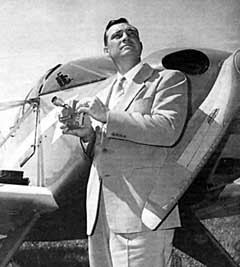flying saucers: a modern myth

Figure 1. Kenneth Arnold.

Figure 2. A purported flying saucer over a house in post-war suburban USA.
'Flying saucer' was a term coined following the reported sighting by Kenneth Arnold (Figure 1), on 24 June 1947, of nine luminous objects in the sky over Washington state. Arnold, a businessman and part-time deputy sheriff was piloting a private plane when he saw the unusual lights heading south from the direction of Mount Baker toward Mount Rainier at what he estimated was a supersonic speed. In describing to reporters later how the objects moved he said that they hugged the contours and appeared to undulate "like a saucer skipping over water." By the time, the story appeared in print his words had been distorted to the phrase "flying saucer." Arnold's sighting, and the great publicity it received, triggered the saucer flap of 1947. Various theories have been put forward to account for the incident, including an especially plausible one which involves the little understood phenomenon of earthlights.
Birth of a modern myth
Extensive media coverage of the first so-called 'flying saucers' observed, on 24 June 1947, near Mount Rainier by businessman Kenneth Arnold opened the floodgates to a deluge of similar sightings. Within three weeks of the Arnold incident, the US military had logged 850 reports from around the nation. Most of these were readily accounted for in terms of astronomical objects, aircraft, hoaxes, and the like. However, inevitably, a few cases proved more difficult to resolve and these provided fertile ground for speculation.
Several factors conspired to see the United States, in the summer of 1947, firmly in the grip of saucer fever. It was only a decade since the mass panic instigated by the The War of the Worlds radio play. That broadcast had gone out on the eve of war in Europe, at a time when the sight and sound of Hitler's fanatical storm-troopers in Berlin was bringing home to people everywhere the very real possibility of invasion by a powerful, single-minded enemy. Now the War was over, Germany and Japan had been defeated, but a general nervousness pervaded America about the new threat of communism. The public and military alike were alive to the possibility of preemptive aerial attack by the Soviets, perhaps using weapons of advanced design smuggled out of Nazi Germany. It is not difficult to understand, following the media hype surrounding Arnold's sighting, people's preoccupation with what might be going on in the skies overhead, nor the ease with which, in all the excitement, it was possible for even commonplace phenomena to be misinterpreted. Those who believed the saucers (or "flying disks," as they were also known) were both real and artificial, could choose between the theory that they were man-made and the extraterrestrial hypothesis.
Arnold, Kenneth (1915–1984)
Kenneth Arnold was a businessman, part-time deputy sheriff, and accomplished private pilot whose sighting of luminous objects, while flying his own Callair plane, over the Cascades, marked the start of the saucer flap of 1947.
Arnold was returning from Chehalis to Yakima, Washington, after a business trip, when he heard that a C-46 transport plane belonging to the US Marine Corps had come down near Mount Rainier. In the hope of claiming a $5,000 government reward, he determined to spend an hour or so searching for the wreckage. While making a 180-degree turn above the town of Mineral, at an altitude of 2,800 meters (9,200 feet), "a tremendously bright flash lit up the surfaces of my aircraft." At 2.59 pm, he observed "a formation of very bright objects coming from the vicinity of Mount Baker, flying very close to the mountaintops and traveling at tremendous speed." Using the clock on his instrument panel, and Mounts Rainier and Adams as markers, and estimating that the formation would pass about 35 kilometers (23 miles) in front of him, Arnold calculated that the objects were traveling at over 2,720 kilometers per hour (1,700 mph). Since they appeared to be flying in formation and, therefore, in Arnold's view artificial, this speed was astounding. Only later that year would the sound barrier, of about 1,200 kilometers per hour (750 mph), be broken by Chuck Yeager in a jet aircraft.
Commented Arnold: "They didn't fly like any aircraft I had seen before ... They flew in a definite formation, but erratically ... like speed boats on rough water or similar to the tail of a Chinese kite ... they fluttered and sailed, tipping their wings alternately and emitting those very bright blue-white flashes from their surfaces." It was while describing his encounter to reporters later the same day that the term "flying saucer" was coined.
Flying disks
'Flying disk' was an alternative description, commonly used between 1947 and 1952, for the phenomenon also known as flying saucers. It appears to have been the preferred term in military circles until it was superseded by 'unidentified flying object' at the start of Project Blue Book.
Alternatively, 'flying disk' was a popular description for the Avrocar experimental aircraft. Incidentally, there is no possibility that the Avrocar, despite its appearance, could have been responsible for any UFO reports, since it only flew at test sites and never at more than a couple of meters above the ground.


